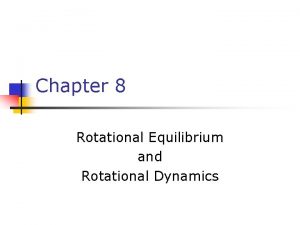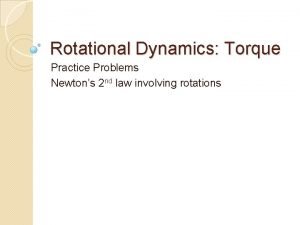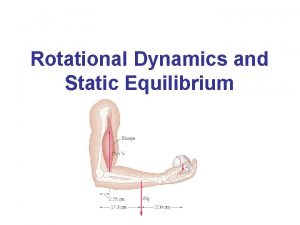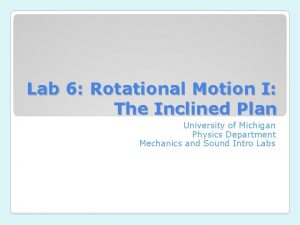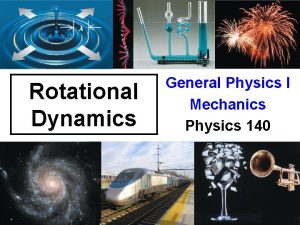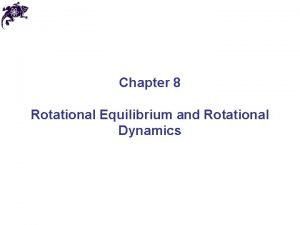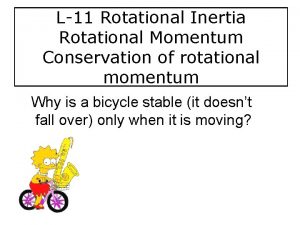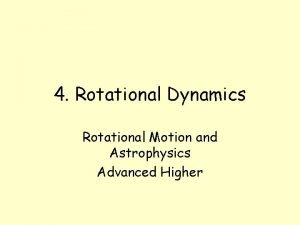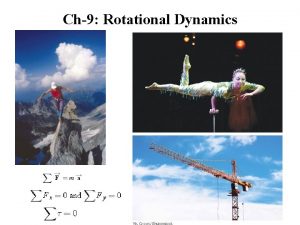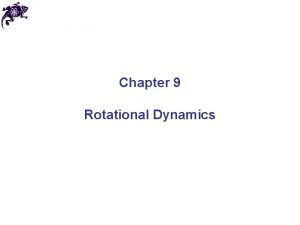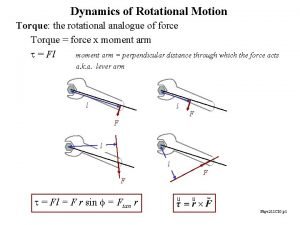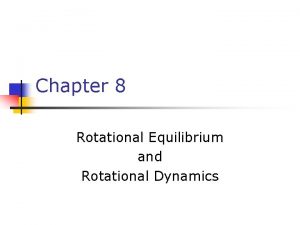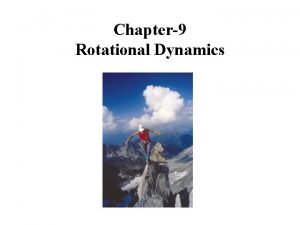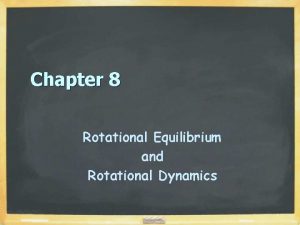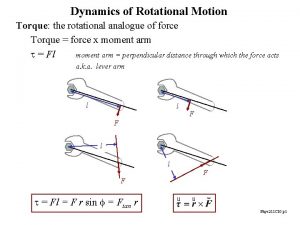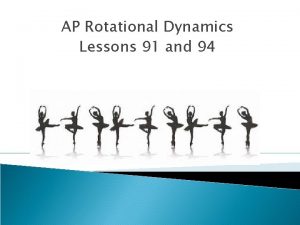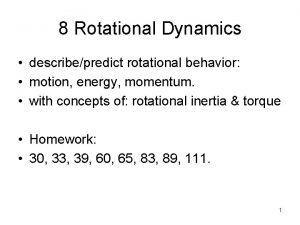Rotational Dynamics Rotational Dynamics The Causes of rotational


















- Slides: 18

Rotational Dynamics

Rotational Dynamics • The Causes of rotational motion! The analogies between linear & rotational motion continue. Newton’s 3 Laws are still valid! • But, here we write them using rotational language and notation.

Translational-Rotational Analogues Continue! ANALOGUES Translation Displacement x Velocity v Acceleration a Force F Rotation θ ω α τ (torque)

Torque • Newton’s 1 st Law (rotational language version): “A rotating body will continue to rotate at a constant angular velocity unless an external TORQUE acts. ” • Clearly, to understand this, we need to define the concept of TORQUE. • Newton’s 2 nd Law (rotational language version): Also needs torque.

• To cause a body to rotate about an axis requires a FORCE, F. (Cause of angular acceleration α). • BUT: The location of the force on the body and the direction it acts are also important! Introduce the torque concept. • Angular acceleration α F. From experiment! • But also α (the distance from the point of application of F to the hinge = Lever Arm, r )

Definition of Torque τ Fr r Lever Arm Direction The torque is positive when the force tends to produce a counterclockwise rotation about the axis, and negative when the force tends to produce a clockwise rotation. SI Unit for. Torque: newton · meter (N · m) or (N · m) 6

Lever Arm Angular acceleration α force F, but also distance from the point of application of F to the hinge (“Lever Arm”) FA = FB, but which gives a greater α ? Hinge RA, RB ≡ “Lever Arms” for FA & FB. α “Lever Arm”

The line of action is an extended line drawn colinear with the force. The lever arm is the distance between the line of action and the axis of rotation, measured on a line that is perpendicular to both. The torque is represented by the symbol t (Greek letter tau), and its magnitude is defined as the magnitude of the force times the lever arm. 8

Lever Arm • Lever Arm r = distance of the axis of rotation from the “line of action” of force F • r = Distance which is to both the axis of rotation and to an imaginary line drawn along the direction of the force (“line of action”). • Find: Angular acceleration α (force) (lever arm) = Fr Define: TORQUE Lower case τ causes α Greek “tau” τ Fr (Just as in the linear motion case, F causes a)

Door Hinge Forces at angles are less effective Torques: Due to FA: r. A τ A = r AF A Due to FC : τC = r. CFC Due to FD: τD = 0 r. C is the Lever Arm for FC r. C (Since the lever arm is 0) τC < τA (For FC = FA) The lever arm for FA is the distance from the knob to the hinge. The lever arm for FD is zero. The lever arm for FC is as shown.

In general, write τ = r F These are the r = r sinθ τ = r. F sinθ OR, resolve F into components F & F same, of course! Units of τ: Nm=m. N τ = r. F F = F sinθ F = F cosθ τ = r. F sinθ

Torque • In general, write τ = r F • Or, resolving F into components F|| and F : τ = r. F • Even more generally: τ = r. F sinθ • Units of torque: Newton-meters (N m)

Example: Biceps Torque τ = r F = 35 m N τ = r F = 30 m N

Exercise B

More than one torque? • If there is more than one torque: α τnet = ∑τ = sum of torques • Always use the following sign convention! Counterclockwise rotation + torque Clockwise rotation - torque

Example r = r. Bsin 60º -------> τB = -r. BFBsin 60º 2 thin disk-shaped wheels, radii r. A = 30 cm & r. B = 50 cm, are attached to each other on an axle through the center of each. Calculate the net torque on this compound wheel due to the 2 forces shown, each of magnitude 50 N. τ = τA + τB = - 6. 7 m N τ A= r AF A

Problem τA = - (0. 24 m)(18 N) = - 4. 32 m N τB = + (0. 24 m)(28 N) = 6. 72 m N τC = - (0. 12 m)(35 N) = - 4. 2 m N τfr = + 0. 4 m N 12 cm 35 N 28 N 24 cm 18 N Net torque: ∑τ = τA + τB + τC + τfr = -1. 4 m N

Translational-Rotational Analogues & Connections Continue! Displacement Velocity Acceleration Force (Torque) Mass Translation x v a F m CONNECTIONS v = rω atan= rα a. R = (v 2/r) = ω2 r τ = r F Rotation θ ω α τ ?
 Torque free body diagram
Torque free body diagram Rotational equilibrium
Rotational equilibrium Proximate causes vs ultimate causes
Proximate causes vs ultimate causes Social behavior examples in animals
Social behavior examples in animals Torque practice problems
Torque practice problems Static equilibrium rotational motion
Static equilibrium rotational motion Rotational dynamics lab
Rotational dynamics lab Rotational dynamics
Rotational dynamics Trời xanh đây là của chúng ta thể thơ
Trời xanh đây là của chúng ta thể thơ Các số nguyên tố
Các số nguyên tố Tỉ lệ cơ thể trẻ em
Tỉ lệ cơ thể trẻ em Tia chieu sa te
Tia chieu sa te Các châu lục và đại dương trên thế giới
Các châu lục và đại dương trên thế giới Thế nào là hệ số cao nhất
Thế nào là hệ số cao nhất Hệ hô hấp
Hệ hô hấp ưu thế lai là gì
ưu thế lai là gì Tư thế ngồi viết
Tư thế ngồi viết đặc điểm cơ thể của người tối cổ
đặc điểm cơ thể của người tối cổ Bàn tay mà dây bẩn
Bàn tay mà dây bẩn
